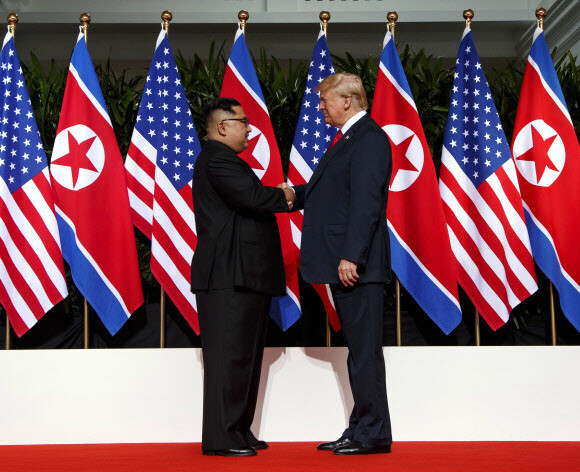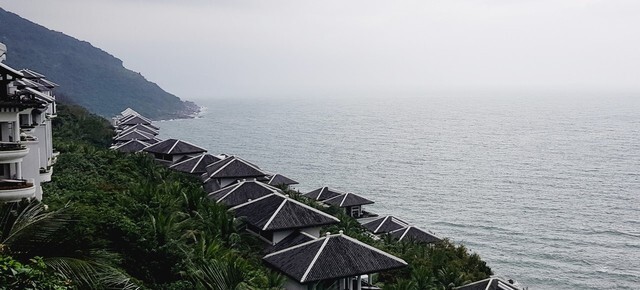hankyoreh
Links to other country sites 다른 나라 사이트 링크
[News analysis] Mounting expectations for the 2nd N. Korea-US summit

The fateful dice have been cast for the second summit of US President Donald Trump and North Korean leader Kim Jong-un. Given Trump’s announcement during his State of the Union address on Feb. 5 that he will be meeting Kim in Vietnam on Feb. 27 and 28, the timeframe has been set for the second summit for creating a peace regime and achieving the denuclearization of the Korean Peninsula.
Just as with the first North Korea-US summit on Sentosa Island in Singapore eight months earlier, the second summit was arranged through a “top down” decision by the two leaders that broke through a long impasse. Trump made his announcement about the date and host country of the second summit two hours after US State Department Special Representative for North Korea Stephen Biegun arrived in Pyongyang for working-level negotiations with Kim Hyok-chol, his North Korean counterpart. In effect, Trump hammered down the timeframe of the summit even before discussion could begin about North Korea’s steps toward denuclearization and the US’ corresponding measures, which are the summit’s key agenda.
This can be taken as demonstrating Trump’s determination to hold the summit, despite strong skepticism among American government officials and the general public. “Much work remains to be done, but my relationship with Kim Jong-un is a good one,” Trump said during the State of the Union address.

Despite a series of setbacks, including the cancellation of high-level talks between North Korean and US officials in Nov. 2018, Trump and Kim have maintained their commitment to dialogue and their mutual trust by exchanging a number of personal letters around the turn of the year. The working-level talks and other preparations for the summit picked up momentum when Kim Yong-chol, vice chairman of the Workers’ Party of Korea (WPK) and director of the WPK United Front Department, delivered a personal letter from Kim to the White House and sat down with Trump on Jan. 18.
During their first summit on June 12, 2018, Trump and Kim released a joint statement in which they agreed on four things: establishing a new relationship between their two countries, building a peace regime on the Korean Peninsula, striving for the denuclearization of the peninsula, and repatriating POW/MIA remains. There has been continuing criticism about a lack of concrete progress on any of these agreements, aside from the repatriation of the remains of US troops.
Whereas the significance of the first summit largely derived from the fact that Trump and Kim were meeting, the second summit poses the challenge of reaching an agreement to exchange progress toward denuclearization for corresponding measures. The current discussion is reportedly focused on North Korea’s dismantlement of its Yongbyon nuclear facilities and on what the US will provide in exchange. The US is reportedly considering options such as resuming humanitarian aid, making an end-of-war declaration and setting up a North Korea-US liaison office, while doing its best to defer any discussion of easing sanctions.
Recently, the US has been sending positive signals to North Korea and revealing its expectations for the outcome of the summit. During an address at Stanford University on Jan. 31, Biegun adopted a more flexible attitude, postponing the US’ demand for North Korea to disclose its nuclear inventory and declaring that denuclearization could take place “simultaneously and in parallel.”
During an interview with CBS on Feb. 3, Trump acknowledged that the US intelligence community might be correct in its skeptical assessment of North Korean denuclearization, while remaining upbeat, saying, “There’s also a very good chance that we will make a deal.” Trump added that Kim “has a chance to have North Korea be a tremendous economic behemoth.”

2-day format leaves more room for productive discussion
The fact that this second summit will run for two days – in contrast with the first summit, which ran for just one – not only underlines the two sides’ determination to get definite results but also represents progress in and of itself. During the first summit, a one-on-one meeting led to an expanded meeting and a work lunch, but this time around, the two leaders can have more in-depth deliberations and build their relationship through a formal dinner or other social events.
“I think they’re planning to have a dinner on the first day of the summit and then to have more socializing on the second day along the lines of the ‘footbridge meeting’ [in an inter-Korean summit] or what we saw in Dalian last year [in a North Korea-China summit]. I think they want to organize an event that can show that trust has been built between North Korea and the US,” said Cho Sung-ryul, a senior research fellow for the Institute for National Security Strategy.
Possibility of China-US summit
Hopes are also being raised by indications that a China-US summit could be held to coincide with the second North Korea-US summit. Though the Blue House has said that it’s still unlikely that South Korean President Moon Jae-in will visit Vietnam for the summit, Cho raised the possibility of an end-of-war declaration being made by South Korea, North Korea, the US and China during the summit.
“Since the summit will last for two days, the Chinese leader and the South Korean leader could show up, too. You don’t need a lot of time for the summit itself. We can’t rule out an end-of-war declaration,” said Koo Kab-woo, a professor at the University of North Korean Studies.
The big question is how much of a compromise can be reached on denuclearization and corresponding measures by North Korean and US working-level negotiators who are hammering out the details of the agenda. There are expected to be several more rounds of negotiations between the teams led by Biegun and Kim Hyok-chol during the three weeks that remain before the summit.
By Hwang Joon-bum, Washington correspondent, and Noh Ji-won, staff reporter
Please direct comments or questions to [english@hani.co.kr]

Editorial・opinion
![[Column] Park Geun-hye déjà vu in Yoon Suk-yeol [Column] Park Geun-hye déjà vu in Yoon Suk-yeol](https://flexible.img.hani.co.kr/flexible/normal/500/300/imgdb/original/2024/0424/651713945113788.jpg) [Column] Park Geun-hye déjà vu in Yoon Suk-yeol
[Column] Park Geun-hye déjà vu in Yoon Suk-yeol![[Editorial] New weight of N. Korea’s nuclear threats makes dialogue all the more urgent [Editorial] New weight of N. Korea’s nuclear threats makes dialogue all the more urgent](https://flexible.img.hani.co.kr/flexible/normal/500/300/imgdb/original/2024/0424/7317139454662664.jpg) [Editorial] New weight of N. Korea’s nuclear threats makes dialogue all the more urgent
[Editorial] New weight of N. Korea’s nuclear threats makes dialogue all the more urgent- [Guest essay] The real reason Korea’s new right wants to dub Rhee a founding father
- [Column] ‘Choson’: Is it time we start referring to N. Korea in its own terms?
- [Editorial] Japan’s rewriting of history with Korea has gone too far
- [Column] The president’s questionable capacity for dialogue
- [Column] Are chaebol firms just pizza pies for families to divvy up as they please?
- [Column] Has Korea, too, crossed the Rubicon on China?
- [Correspondent’s column] In Japan’s alliance with US, echoes of its past alliances with UK
- [Editorial] Does Yoon think the Korean public is wrong?
Most viewed articles
- 1‘We must say no’: Seoul defense chief on Korean, USFK involvement in hypothetical Taiwan crisis
- 2N. Korean delegation’s trip to Iran shows how Pyongyang is leveraging ties with Moscow
- 3Amnesty notes ‘erosion’ of freedom of expression in Korea in annual human rights report
- 4[Column] Park Geun-hye déjà vu in Yoon Suk-yeol
- 5‘Weddingflation’ breaks the bank for Korean couples-to-be
- 6[Reportage] On US campuses, student risk arrest as they call for divestment from Israel
- 7[Guest essay] The real reason Korea’s new right wants to dub Rhee a founding father
- 8[Editorial] New weight of N. Korea’s nuclear threats makes dialogue all the more urgent
- 9Will NewJeans end up collateral damage in internal feud at K-pop juggernaut Hybe?
- 10Why Korea shouldn’t welcome Japan’s newly beefed up defense cooperation with US